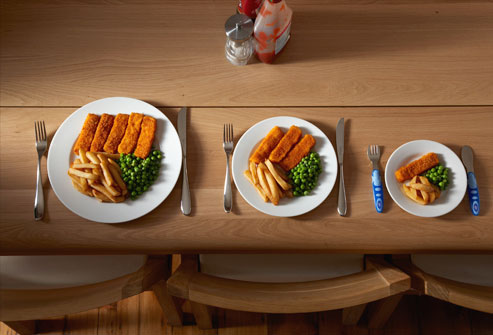
How Portion Size, Energy Density, and Variety Shape What We Eat
Share
Have you ever wondered why you sometimes eat more than you intended? It turns out that the way food is served and presented can strongly influence how much we eat. Researchers call the biggest influences on food intake “The Big Three”: portion size, energy density, and variety. Understanding how these work can help you make better choices and stay on track with healthy eating goals.
Portion Size: Bigger Plates, Bigger Appetites
One of the clearest findings from research is that people eat more when they are served more. This happens with adults and children alike. Even when people aren’t particularly hungry, they tend to eat more food just because more is available on the plate.
For example, in studies where pasta portions were increased, people ate more without feeling fuller. And the effect isn’t short-term. When people were served larger meals for several days, they didn’t naturally eat less later to make up for it.
A simple tip to manage this is to serve smaller portions, especially of high-calorie foods. At the same time, you can increase the amount of fruits and vegetables to help fill your plate. This way, you feel satisfied without overeating.
Energy Density: Calories Creep In
Energy density refers to how many calories a food has per gram. Foods that are high in fat and sugar usually have more calories packed into smaller amounts. On the other hand, foods with more water or fiber—like fruits and vegetables—are low in energy density.
Here’s why this matters: people tend to eat about the same weight of food each day. So, if the food is high in energy density, they end up eating more calories without realizing it.
You can lower the energy density of your meals by adding more water-rich foods like soups, salads, and fruits. Even small changes—like switching from fried to baked items, or choosing a broth-based soup instead of cream-based—can make a big difference.
Variety: More Choices, More Eating
We’ve all had that moment where we say we’re full, but then somehow find room for dessert. This happens because of something called “sensory-specific satiety.” Basically, we get bored of one taste quickly, but our interest gets renewed when a new flavor or texture is offered.
When meals offer more variety—especially in flavors, colors, or textures—people eat more. This isn’t always a bad thing. If you serve a variety of vegetables, you’re likely to eat more of them. But if the variety comes from chips, cookies, and sugary drinks, it can lead to overeating.
Try using variety wisely. Offer different types of vegetables or fruits at meals. This way, you get the benefits of variety without adding unnecessary calories.
Smart Strategies for Real Life
Understanding these three food properties can help you take control of your eating habits without feeling deprived. Here are some practical tips:
- Use smaller plates and bowls to help control portion sizes
- Start meals with a salad or broth-based soup to reduce overall calorie intake
- Add more fruits and vegetables to your meals to lower energy density
- Limit the number of high-calorie snacks or desserts on the table to reduce overconsumption from variety
- Plan your meals so you know how much food you really need
Why This Matters
Our environment is full of large portions, calorie-rich foods, and endless variety. These cues encourage us to eat more than we need. By being aware of portion size, energy density, and food variety, you can make small changes that add up over time.
Whether you're trying to lose weight, manage your health, or simply eat more mindfully, keeping “The Big Three” in mind is a great place to start. Simple adjustments in what and how you eat can lead to lasting results.
